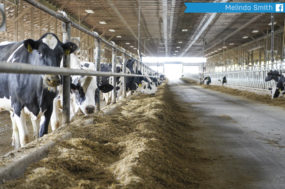With the advances in reproduction and genomics, today’s dairy cows are being dried off at a much higher level than ever before. Cows milking at a higher level are less likely to form a natural keratin plug. As a result, their teat ends may stay open during the entire dry period, making it more likely for environmental bacteria to ascend into the quarter and cause mastitis.
“After dry-off, teats may leak some and there may be physical pressure there that holds the teat end open and doesn’t allow the keratin plug to completely form,” says Linda Tikofsky, senior associate director at Boehringer Ingelheim. “There were a couple of studies done back in the early 2000s where they looked at the percentage of teats that did not close after dry-off. They looked at cows 40 pounds and under per milking and cows milking over 40 pounds at dry-off. In the group that was milking at the higher level, roughly about 50 percent of those cows’ teat ends stayed open well into the dry period.”
For cows that are not able to form a keratin plug, teat sealants are used to mimic the keratin plug that cows should naturally form. A teat sealant is an inert barrier to bacterial migration and provides the first defense against bacterial invasion of that quarter.
“We commonly use it with a dry cow antibiotic which is focused on eliminating any subclinical mastitis those cows may have at dry-off,” Tikofsky says. “Even in a cow that will form a keratin plug, it may be up to two weeks before it's fully formed. So we're giving them some immediate protection at dry-off to prevent bacterial invasion, and then that teat sealant will remain in the quarter until it's stripped out at the end of the dry period or after the cow freshens.”
Milking employees are the first line of defense for mastitis detection in the parlor. When observing for mastitis, they may notice if a cow has a swollen quarter that is red, inflamed and/or sensitive. Their next job as the cows freshen is to collect colostrum. While hand stripping each quarter, milking employees should observe the fluid and material that comes out of the quarter looking for symptoms of mastitis. Is it thick, or is it thin and watery? Are there flakes, clots or evidence of clinical mastitis? Is it teat sealant residue or mastitis?
During the milking process, healthy cows can sometimes be mistakenly flagged for mastitis due to teat sealant residue and differentiating the two. While colored sealants are easier to distinguish from milk, white sealants can be mistaken for mastitic milk.
“There can be a lot of turnover in milking parlors, and getting people trained or refreshing that knowledge may not be done on a regular basis,” Tikofsky says. “So we may have people working in the parlor who aren’t familiar either. If they’re seeing teat sealant and confusing it with mastitis, we may have cows pulled and put into the hospital pen when they can really stay in the normal milking pens.”
Mastitis can present in a few different ways ranging from simple little flakes to thick clumps or garget. Teat sealants, however, will tend to be a little oily. Tikofsky explained that when teat sealant comes out of the teat end, it resembles a toothpaste consistency (Figure 1).

“If you imagine how toothpaste comes out of a tube, particularly in those first strips, we may see toothpaste kind of strings of the sealant rather than mastitis,” Tikofsky says. “You can also certainly test it between your fingers and see if there's an oily consistency to it. For the people who are unsure, have the milking parlor manager or somebody more experienced help evaluate.”
In addition, Tikofsky says there should not be any odor to teat sealant residue. However, mastitis particularly with high levels of white blood cells or bacteria may have an off smell that can sometimes be detected.
“One of the quickest things they can do besides visually looking at the milk would be to do a California Mastitis Test or CMT,” Tikofsky says. “Teat sealant will not alter CMT results because it detects white blood cells. So, we should see a positive CMT if it is mastitis and a negative CMT if it's just teat sealant.”
It is important to correctly differentiate mastitis from teat sealant residue to minimize unnecessary interventions and to make sure we’re using antibiotics judiciously on farms.
“Some farms prefer to treat every case of mastitis. If we are confusing teat sealant with mastitis, there's the potential we may be treating some cows unnecessarily with antibiotics. We'd like to minimize our antibiotic use,” Tikofsky says. “Also, every time we treat cows and instill antibiotics into those quarters, we'll have a milk withdrawal. So that'll end up costing the farm money in both the cost of the medication and largely because of the milk discard and the pounds of milk that are lost.”
Correctly identifying mastitis versus teat sealant also means sending only mastitic cows for further evaluation, which can save time and labor.
Most teat sealants on the market are a combination of some bismuth subnitrate and mineral oil and do not have any impact on residues or somatic cell counts. However, if not stripped out effectively or completely, teat sealant residue may build up in the milking line.
Tikofksy’s advice is to always hand strip until you do not see any more residue teat sealant.
“In my experience, it probably takes a good 10 to 12 strips to really make sure you're working all the teat sealant out of the teat cistern and the streak canal after freshening,” Tikofsky says. “And then if it was my dairy, I would want them to do the 10 to 12 times at least for the first two to three milkings after the cow has freshened. Thereafter, I think our most common protocol is that those cows are hand stripped three to five times.”
One of the keys to proper teat sealant removal is making sure it is applied correctly in the beginning.
“When we put in our dry tube, we massage it up into the quarters. But if we don't have our dry-off crew properly trained, they may do the exact same thing with the teat sealant and massage it up into the quarter as well. So then we have sealant fragments distributed throughout that quarter, which is likely to give us some prolonged removal at freshening,” Tikofsky says. “Make sure your crews are trained so that they pinch off the teat at the base of the udder. Use a two-finger scissor grip while infusing the teat sealant so that it just goes into the teat cistern and streak canal below your pinched grip.”







